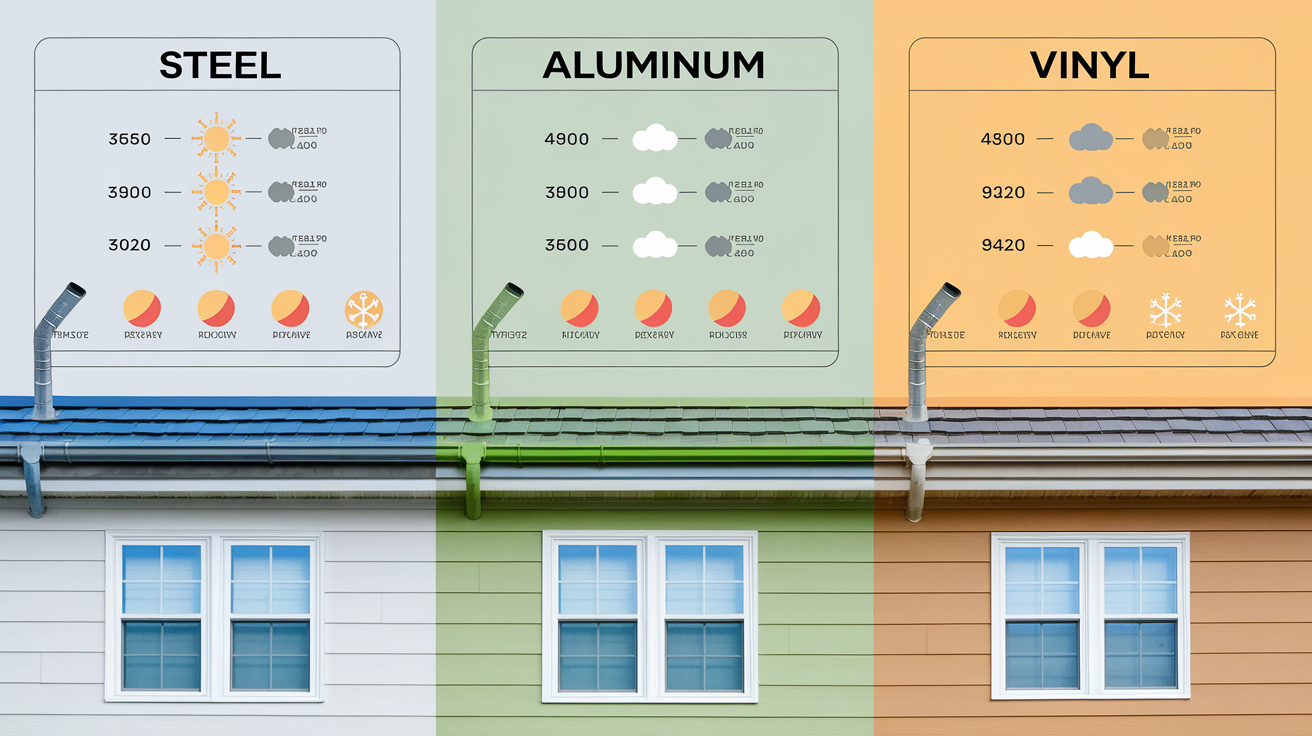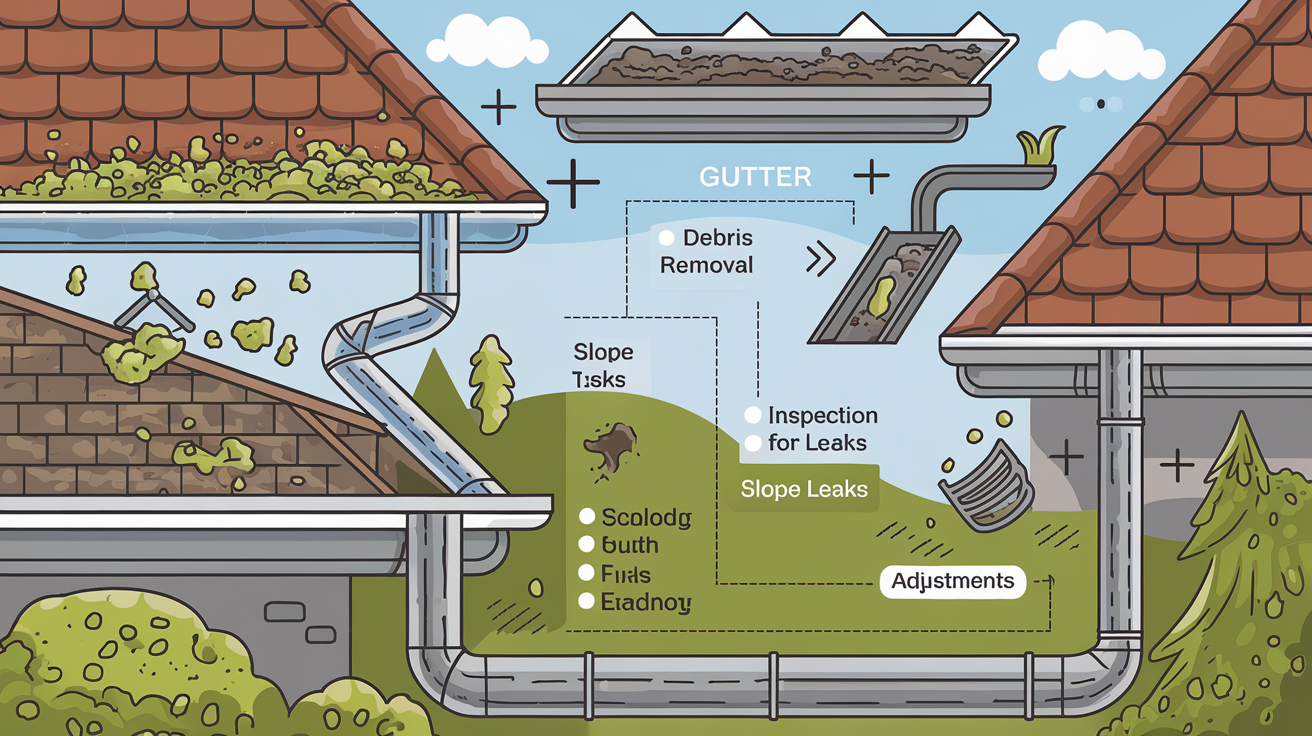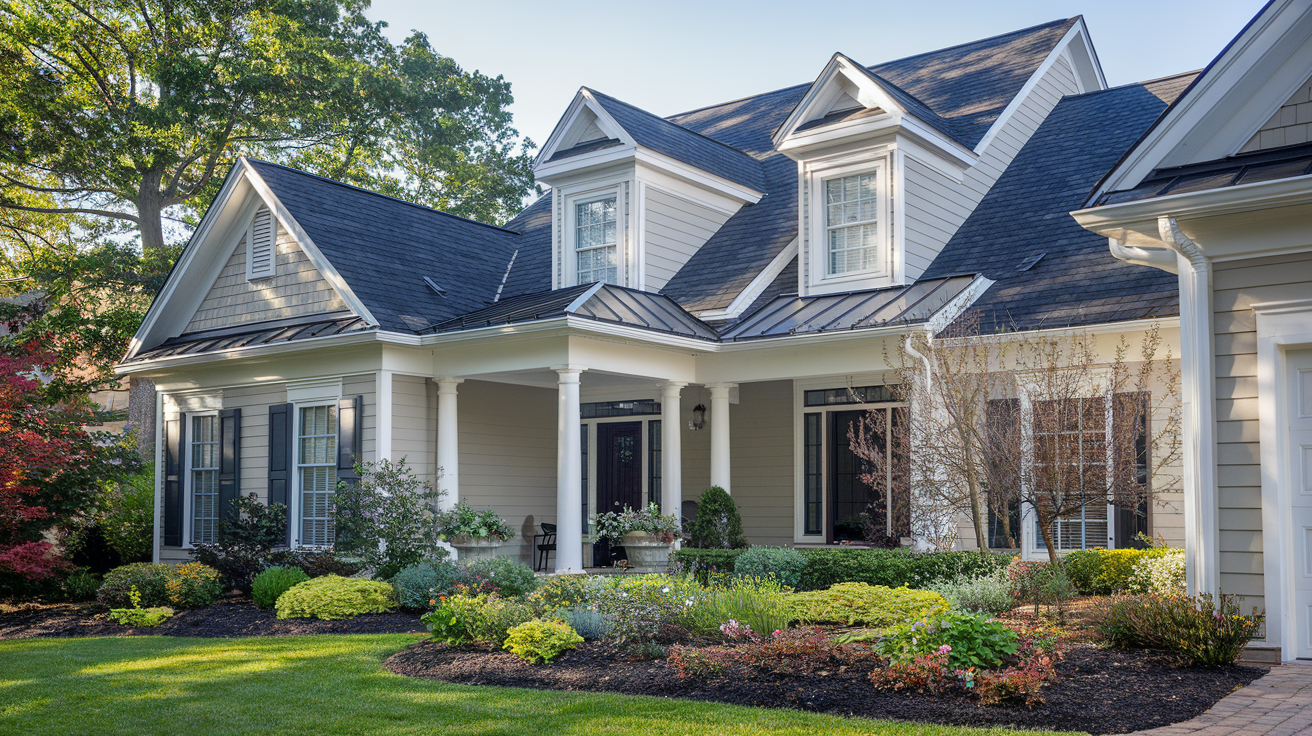Ultimate Guide: How Gutters Protect Your Roof from Costly Water Damage
Did you know that just one inch of water damage can cost homeowners up to $25,000 in repairs? Your home's gutter system is the first line of defense against this costly threat. Yet many homeowners overlook this crucial component of their home's protection until it's too late.
Proper gutter maintenance isn't just about preventing water damage – it's about protecting your entire home's structural integrity. From your roof to your foundation, functioning gutters shield your home from water-related disasters that can compromise its value and your family's safety. With nearly 98% of basements experiencing water damage at some point, the importance of a well-maintained gutter system cannot be overstated.
In this comprehensive guide, you'll discover essential maintenance practices, learn to identify warning signs of gutter problems, and understand when to call in professionals. We'll explore how different gutter materials perform in various climates and share expert tips for extending your gutter system's lifespan.
- How Gutters Safeguard Your Roof
- Understanding the Gutter and Roof Connection
- Common Consequences of Neglected Gutter Maintenance
- Essential Gutter Maintenance Practices
- Selecting and Caring for Your Gutter System
- Identifying Gutter Issues and Knowing When to Seek Help
- Conclusion: The Lasting Advantages of Proper Gutter Maintenance
The Critical Role of Gutters in Preventing Roof Water Damage
Gutters are essential for protecting your home from water damage by channeling rainwater away from your roof and foundation. This prevents costly problems like roof leaks and structural damage. Without properly functioning gutters, water can pool, leading to rot and decay that weakens your home. Regular gutter maintenance and inspection are key to preventing these issues.
How Gutters Safeguard Your Roof
Gutters protect your roof by directing water away from its surface and your home's foundation. This prevents water from pooling and causing leaks and rot. Clogged gutters can overflow during rainstorms, leading to water accumulation on the roof and subsequent leaks. Gutters also extend the life of your roofing materials by reducing their exposure to excess moisture. By channeling water away, gutters protect your roof and its underlying structure. They also safeguard your foundation from cracks and other structural issues by diverting water away from your home's base. For more information on maintaining your roof, learn more about roof maintenance.
Key Benefits of Gutters
- Prevents water pooling on the roof
- Reduces risk of leaks and rot
- Extends the lifespan of roofing materials
- Protects foundation from structural damage
Understanding the Gutter and Roof Connection
Gutters and your roof work together in a complex system. Gutters collect rainwater and carry it through downspouts, directing it away from your foundation. This system prevents water buildup that can cause foundation cracks and other structural problems. Your roof's slope is also important for proper drainage. A well-sloped roof helps water flow smoothly into the gutters, preventing pooling. The size of your gutters, outlets, and downspouts is critical for managing rainwater, especially during heavy storms. These components must be properly sized to handle the expected water volume in your area. A Get Your Roof Assessment can help determine if your current gutter system is adequate.
Common Consequences of Neglected Gutter Maintenance
Neglecting gutter maintenance can lead to many problems for your roof and home. Clogged gutters can overflow, causing water to pool on your roof and lead to leaks and rot. This pooling weakens the roof deck, making it more vulnerable to damage. Water can also seep into your home's interior, damaging ceilings and walls. Just an inch of water can cause significant damage, costing up to $25,000. This can include damage to belongings and the cost of structural repairs. Heavy debris in gutters can cause them to sag or detach from the roof, making them less effective. Almost all gutters eventually fail, even if properly installed, highlighting the importance of regular maintenance. Regular cleaning and inspection are crucial. Cleaning your gutters twice a year, in spring and fall, is recommended. DIY gutter cleaning can be dangerous; consider hiring a professional.
| Problem | Effect |
|---|---|
| Clogged Gutters | Causes overflow, leading to leaks and rot |
| Sagging Gutters | Can detach from the roof, reducing effectiveness |
| Detached Gutters | Leads to water pooling and structural damage |
Essential Gutter Maintenance Practices
Maintaining your gutters is key to protecting your roof and home from water damage. Neglected gutters can lead to expensive repairs. Overflowing water can damage your roof, walls, and even your foundation. For example, just one inch of water inside a typical home can cause $1,322 to $5,954 in damage. This includes damage to walls, flooring, and personal belongings. Effective gutter maintenance involves regular cleaning, inspections for damage, and ensuring proper installation. By following these practices, you can prevent water damage and extend the life of your roofing materials. This also means your roof will last longer and need fewer repairs. Let's explore the essential maintenance practices every homeowner should follow. Consider scheduling a Get Your Roof Assessment to identify potential vulnerabilities and ensure your roof is properly protected.
Regular Cleaning and Debris Removal
One of the most common gutter problems is clogging from debris like leaves and twigs. Gutters channel water, and debris blocks this flow. Clogged gutters overflow during rainstorms, causing water to pool on the roof, potentially leading to leaks. This pooling can cause roof rot, weakening the roof deck and creating serious structural problems. The roof deck supports the roofing materials, and rot can compromise its integrity, potentially leading to collapse. To avoid these problems, clean your gutters at least twice a year. Spring and fall, after the leaves have fallen, are ideal times. Regular cleaning keeps water flowing smoothly and reduces the risk of gutter failure. Approximately 99% of gutter systems fail at some point, even with proper installation. While most gutters experience some problems, regular maintenance can significantly extend their lifespan. For safety, hire professionals. DIY gutter cleaning is dangerous and can lead to injuries requiring emergency room visits. These injuries can include falls from ladders and cuts from sharp debris. To learn more, learn more about roof maintenance.
Inspection for Damage and Timely Repairs
Regular inspections are crucial. They help you find and fix gutter damage before it gets worse. Look for sagging, leaks, and improper slope. These problems can make your gutters less effective and let water into your house. Sagging gutters can mean weak hangers or too much debris. Leaks can be from holes, cracks, or loose joints. An improper slope stops water from flowing to the downspouts and away from your home. You might see standing water in the gutters, even after the rain stops. It's important to fix any damage quickly to prevent bigger problems. Gutter repair costs vary based on the material, the length of the damaged section, and the type of damage. Repairs typically cost between $100 and $450. Adjusting a gutter's pitch, which ensures proper water flow to the downspouts, costs $75 to $200. Timely repairs prevent more serious structural damage, keeping your gutters effective at channeling water away from your roof and foundation.
Ensuring Correct Installation and Slope
Proper installation and slope are essential for your gutters to work well. Gutters need a slight slope so water flows towards the downspouts. This prevents water from pooling and overflowing. The slope uses gravity to move the water efficiently. A typical slope is 1/4 inch for every 10 feet of gutter. Gutter hangers should be no more than three feet apart. This spacing provides support, especially during heavy rain. The right spacing prevents sagging and ensures the gutters can handle the weight of water and debris. Correct installation and slope improve the performance and lifespan of your gutter system, protecting your home from water damage.
Selecting and Caring for Your Gutter System
Choosing the right gutter system and maintaining it properly is crucial for protecting your home from water damage. A well-maintained gutter system directs rainwater away from your roof, preventing issues like roof rot, which can weaken the roof and lead to costly repairs inside your home. Efficient gutters also help your roof last longer. This section explains how to choose the right gutter materials for your climate, offers seasonal maintenance tips, and discusses the advantages of gutter guards and screens.
Choosing the Best Materials for Your Climate
Understanding your local climate is the first step in selecting the right gutter materials.

Vinyl Gutters
Vinyl gutters are a budget-friendly option that works well in mild, dry climates. However, they may not be suitable for areas with heavy snow or frequent freezing temperatures. Vinyl gutters typically last 10-15 years.
Steel Gutters
Steel gutters are a more durable choice and can handle harsh weather better than vinyl or aluminum. Galvanized steel gutters are especially strong and resistant to damage, lasting 15-20 years.
Aluminum Gutters
Aluminum gutters are a versatile option suitable for a variety of climates. With proper maintenance, they can last 20-30 years. This balance of affordability and lifespan makes them a popular choice. When choosing your gutter material, consider your local weather, expected lifespan, and budget. Vinyl and plastic are generally the most affordable options. While the national average cost for k-style gutters is around $26 per linear foot, prices vary depending on the material. For example, copper gutters, which can last 50+ years, are significantly more expensive than vinyl. The material you choose is the biggest factor affecting installation costs, which typically range from $625 to $1,717, with a national average of about $1,171.
Seasonal Maintenance Guidelines
Regular maintenance is key to keeping your gutters working effectively.
Spring and Fall Cleaning
Cleaning your gutters at least twice a year, in the spring and fall, prevents clogs and ensures proper water flow. Remove leaves, twigs, and other debris that can obstruct drainage.

Inspecting Your Gutter System
Your gutter system includes gutters, downspouts, end caps, and miters. End caps seal the ends of the gutters and direct water flow towards the downspouts. All these components work together to manage rainwater runoff. During your cleaning, check for sagging or leaks, which can result from loose hangers or improper gutter slope. Gutter hangers should be no more than three feet apart, although this can vary based on climate and gutter type. Addressing these problems early can prevent costly repairs, which average $100 to $450 depending on the damage and materials, and extend the life of your gutter system.
Safety and Neglect
Avoid attempting DIY gutter cleaning, as it can be dangerous and lead to injuries requiring emergency room visits. Neglecting gutter maintenance can lead to clogs and expensive repairs. Consider getting a Get Your Roof Assessment to identify potential issues. You can learn more about roof maintenance to understand the importance of a well-maintained roof and gutter system.
The Benefits of Gutter Guards and Screens
Gutter guards and screens can significantly reduce the amount of debris that enters your gutters. They allow water to flow freely while blocking leaves, twigs, and other debris.
Gutter Guards: Pros and Cons
- Reduce maintenance frequency
- Protect against debris buildup
- Extend gutter lifespan
- Initial installation cost
- May require professional installation
Reduced Maintenance and Protection
By minimizing clogs, gutter guards reduce how often you need to clean your gutters and protect your home from water damage. They can also extend the lifespan of your gutters by preventing debris buildup that can lead to corrosion and structural damage. This is important because even properly installed gutters are prone to eventual failure.
Cost-Effective Investment
Investing in quality gutter guards is a cost-effective way to improve the performance and longevity of your gutter system.
Identifying Gutter Issues and Knowing When to Seek Help
This section helps you identify common gutter problems and understand when it's time to call a professional. Well-maintained gutters protect your home from water damage, but neglecting them can lead to costly repairs.
Spotting Clogs and Overflows
Clogged gutters are a common problem. Debris like leaves and twigs accumulate, preventing water from flowing freely. This can lead to overflows, causing water to spill over the sides and pool around your home's foundation. This overflow can damage your roof and siding, potentially leading to leaks and structural issues. Standing water on your roof can also cause roof rot, weakening the roof deck. One inch of water in a typical home can cause up to $25,000 in damage.
Signs of Clogged Gutters
- Visible debris in the gutters
- Sagging gutters
- Water stains on your siding
- Water overflowing during rainfall
Regular maintenance, like cleaning your gutters at least twice a year—ideally in the spring and fall—can prevent clogs. Learn more about roof maintenance This involves removing debris and flushing the system.
Detecting Structural Compromises
Beyond clogs, gutters can suffer structural damage. This includes sagging, separation, and leaks.
Sagging Gutters
Sagging often happens when gutter hangers are spaced too far apart or become loose. Hangers should be no more than three feet apart, although this can vary based on location, climate, and gutter type.
Joint Separation
Gutters can pull apart at the joints, usually due to the weight of accumulated debris. This added stress weakens the seams and connections.
Leaks
Leaks can develop at the seams or from corrosion, especially in metal gutters. Even durable materials like steel can corrode over time. Regular inspections, at least twice a year, can help you catch these problems early.
When to Contact a Professional for Gutter Concerns
While some gutter maintenance is DIY-friendly, some situations require a professional.
Signs You Need a Pro
- Persistent leaks
- Significant sagging
- Joint separation you can't fix
- Concerns about safety
Even minor problems can escalate, causing water damage to your roof or foundation. DIY gutter cleaning can be dangerous, leading to injuries from falls or improper tool use. Professionals have the right equipment and expertise for safe and effective gutter maintenance. They can also assess your system and recommend solutions like repairs or replacement. Consider a Get Your Roof Assessment to identify potential issues early. Even properly installed gutters can eventually fail. Regular professional inspections and maintenance are crucial for preventing costly water damage.
Conclusion: The Lasting Advantages of Proper Gutter Maintenance
Preserving Your Home's Value
Proper gutter maintenance is essential for preserving your home's value. It's more than just curb appeal. Well-maintained gutters protect your investment by channeling water away from your roof and foundation. This reduces the risk of expensive water damage repairs. Such damage can include problems from sudden events like fire, hail, or vandalism, which your homeowners insurance may cover. By preventing structural problems like basement flooding and foundation cracks, you maintain your property's integrity and market value. According to industry data, almost all basements in the U.S. experience some water damage. This highlights how important effective water management is. Regular gutter cleaning and repairs can save you significant money in the long run. The average cost to repair water damage ranges from $1,322 to $5,954. This is a substantial cost that preventative gutter maintenance can help you avoid. Well-maintained gutters can also be a selling point if you decide to sell your home. Consider a roof assessment to identify potential issues and protect your investment.
Extending the Life of Your Roof
A key benefit of proper gutter maintenance is extending the life of your roof. Gutters direct water away from your roof, preventing water buildup and resulting damage, like roof rot and leaks. Clogged gutters can overflow, leading to water pooling on the roof and leaks. This weakens the roof deck and can mean costly repairs. Regular cleaning and maintenance prevent clogs and protect your roof from water damage. Maintaining your gutters helps your roofing materials last longer, avoiding early replacements and repairs. For example, aluminum and steel gutters last about 20 years with proper maintenance. Other materials, like copper, can last even longer—over 50 years. Learn more about roof maintenance to maximize the lifespan of your roof.

Optimizing Water Management and Preventing Damage
Efficient water management is another crucial benefit of maintaining your gutters. Functioning gutters and downspouts prevent water overflow and damage to your home's exterior and foundation. This helps avoid problems like soil erosion, basement flooding, and landscape damage.
What Does Efficient Water Management Involve?
Efficient water management means keeping gutters clear of debris, positioned at the correct slope, and securely attached. Regular inspections and maintenance can identify potential problems early. This includes issues like improper gutter slope or loose hangers. Gutter hangers should be no more than three feet apart, depending on climate and gutter type. Cleaning your gutters at least twice a year, especially in the spring and fall, helps prevent clogs and ensures proper water flow. Spring and fall are important because these seasons usually have more leaves and debris. By optimizing your gutter system, you protect your home from water damage and make it more durable and resilient.
Disclaimer: This blog post is intended for informational purposes only and should not be considered professional roofing advice. Always consult with qualified roofing contractors and insurance professionals for specific guidance regarding your individual circumstances.
